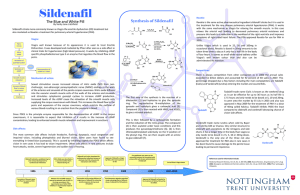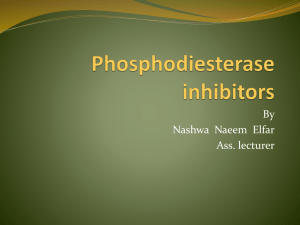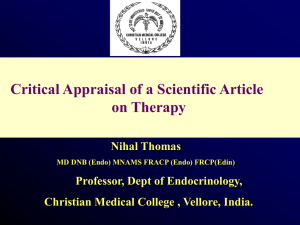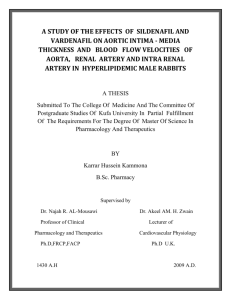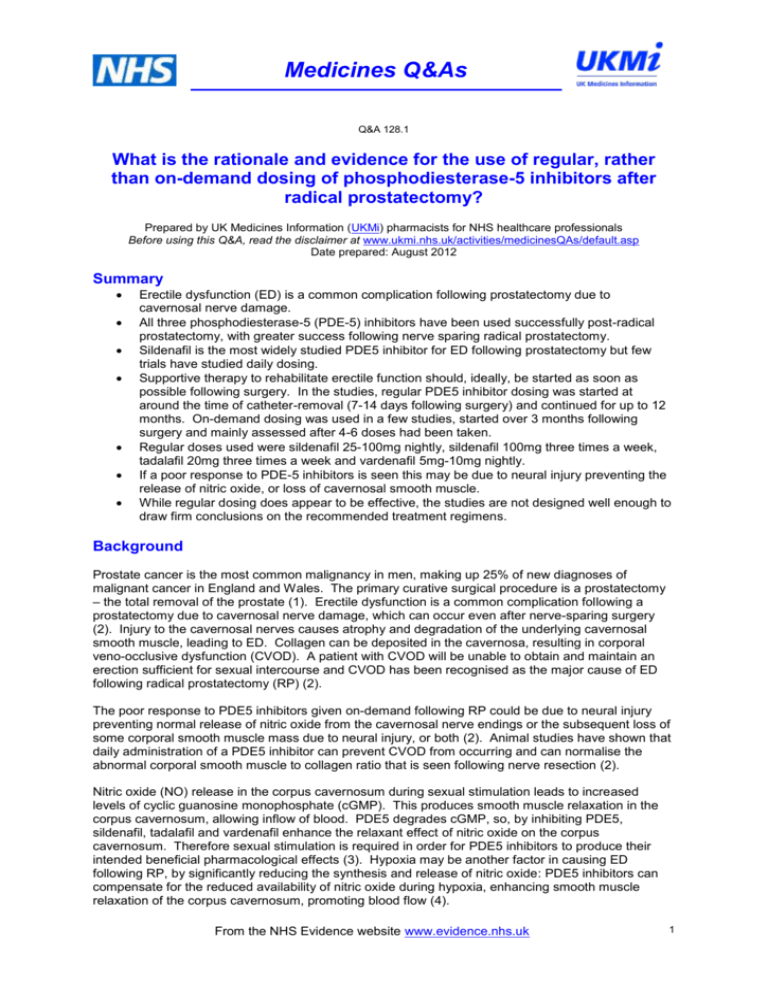
Medicines Q&As
Q&A 128.1
What is the rationale and evidence for the use of regular, rather
than on-demand dosing of phosphodiesterase-5 inhibitors after
radical prostatectomy?
Prepared by UK Medicines Information (UKMi) pharmacists for NHS healthcare professionals
Before using this Q&A, read the disclaimer at www.ukmi.nhs.uk/activities/medicinesQAs/default.asp
Date prepared: August 2012
Summary
Erectile dysfunction (ED) is a common complication following prostatectomy due to
cavernosal nerve damage.
All three phosphodiesterase-5 (PDE-5) inhibitors have been used successfully post-radical
prostatectomy, with greater success following nerve sparing radical prostatectomy.
Sildenafil is the most widely studied PDE5 inhibitor for ED following prostatectomy but few
trials have studied daily dosing.
Supportive therapy to rehabilitate erectile function should, ideally, be started as soon as
possible following surgery. In the studies, regular PDE5 inhibitor dosing was started at
around the time of catheter-removal (7-14 days following surgery) and continued for up to 12
months. On-demand dosing was used in a few studies, started over 3 months following
surgery and mainly assessed after 4-6 doses had been taken.
Regular doses used were sildenafil 25-100mg nightly, sildenafil 100mg three times a week,
tadalafil 20mg three times a week and vardenafil 5mg-10mg nightly.
If a poor response to PDE-5 inhibitors is seen this may be due to neural injury preventing the
release of nitric oxide, or loss of cavernosal smooth muscle.
While regular dosing does appear to be effective, the studies are not designed well enough to
draw firm conclusions on the recommended treatment regimens.
Background
Prostate cancer is the most common malignancy in men, making up 25% of new diagnoses of
malignant cancer in England and Wales. The primary curative surgical procedure is a prostatectomy
– the total removal of the prostate (1). Erectile dysfunction is a common complication following a
prostatectomy due to cavernosal nerve damage, which can occur even after nerve-sparing surgery
(2). Injury to the cavernosal nerves causes atrophy and degradation of the underlying cavernosal
smooth muscle, leading to ED. Collagen can be deposited in the cavernosa, resulting in corporal
veno-occlusive dysfunction (CVOD). A patient with CVOD will be unable to obtain and maintain an
erection sufficient for sexual intercourse and CVOD has been recognised as the major cause of ED
following radical prostatectomy (RP) (2).
The poor response to PDE5 inhibitors given on-demand following RP could be due to neural injury
preventing normal release of nitric oxide from the cavernosal nerve endings or the subsequent loss of
some corporal smooth muscle mass due to neural injury, or both (2). Animal studies have shown that
daily administration of a PDE5 inhibitor can prevent CVOD from occurring and can normalise the
abnormal corporal smooth muscle to collagen ratio that is seen following nerve resection (2).
Nitric oxide (NO) release in the corpus cavernosum during sexual stimulation leads to increased
levels of cyclic guanosine monophosphate (cGMP). This produces smooth muscle relaxation in the
corpus cavernosum, allowing inflow of blood. PDE5 degrades cGMP, so, by inhibiting PDE5,
sildenafil, tadalafil and vardenafil enhance the relaxant effect of nitric oxide on the corpus
cavernosum. Therefore sexual stimulation is required in order for PDE5 inhibitors to produce their
intended beneficial pharmacological effects (3). Hypoxia may be another factor in causing ED
following RP, by significantly reducing the synthesis and release of nitric oxide: PDE5 inhibitors can
compensate for the reduced availability of nitric oxide during hypoxia, enhancing smooth muscle
relaxation of the corpus cavernosum, promoting blood flow (4).
From the NHS Evidence website www.evidence.nhs.uk
1
Medicines Q&As
Oral PDE5 inhibitors can be prescribed on the NHS to treat erectile dysfunction following
prostatectomy (5), but what evidence is there to support the daily or regular dosing schedules used
following RP?
Answer
Recovery of erectile function following radical prostatectomy (RP) can take up to 24 months, but,
because lack of oxygenation in the corpus cavernosal can lead to involuntary atrophy due to
increasing fibrosis of the smooth muscle, supportive therapy to rehabilitate erectile function should be
started as early as possible (6-8). The focus of therapy for ED following RP is preservation and
rehabilitation of erectile function; one such method is the use of PDE5 inhibitors (6). The efficacy of
the PDE5 inhibitor depends on preservation of the nerves during surgery; without cGMP there is no
substrate for PDE5 to work on (9). Men undergoing bilateral or unilateral prostatectomy have been
shown to have a better response to a PDE5 inhibitor than those who had non-nerve-sparing surgery
(10-12).
Only one study has compared on-demand with regular treatment and with placebo (13). Others have
compared regular treatment with placebo or a comparator. Erectile function was assessed using the
International Index of Erectile Function (IIEF) and Sexual Encounter Profile (SEP) questions, and
scores are detailed in Appendix 1. Different items on the IIEF scale were used in different trials, such
as the IIEF-5 (5 specific questions including those on erectile function) or the IIEF-EF (items from the
erectile function domain of the scale). Summarised details of the on-demand studies are included for
completeness.
Doses used in the studies are:
Sildenafil 25-100mg nightly
Sildenafil 100mg three times a week
Tadalafil 20mg three times a week
Vardenafil 5mg-10mg once a day or at night
The recommended dosing of sildenafil, tadalafil and vardenafil is one dose prior to sexual activity; the
maximum recommended dosing frequency is once a day (3;14;15). PDE5 inhibitors can be
prescribed on the NHS following prostatectomy for the treatment of impotence (16). The prescribing
doctor can prescribe more than one dose a week if judged clinically appropriate; the daily use of a
PDE5 inhibitor would not exceed the licensed recommended doses.
Clinical evidence
A limitation of all of these studies is the treatment duration. Up to 36 months of rehabilitation of EF
may be required following RP (6).
Sildenafil: regular dosing
A number of studies have evaluated the use of daily sildenafil dosing in men following nerve sparing
radical prostatectomy (4;6).
Bannowsky et al (6) studied 11 men who had unilateral and 32 men who had bilateral nerve sparing
radical prostatectomy (NSRP); 41 had nocturnal erections following catheter removal. Subsequently
23 men started treatment with sildenafil 25mg and 18 men with placebo, given nightly when the
indwelling catheter was removed, approximately 7-14 days following surgery. The design of the study
is poorly reported. The total duration of treatment with sildenafil is not clear and an assumption is
made that it was continued for up to 52 weeks. There was no indication that men could also use
additional treatment, with on-demand sildenafil (50-100mg) until this is discussed in the results.
Significant differences in the IIEF-5 scores between the sildenafil and placebo groups were seen at
weeks 36 and 52 (p<0.001 at both weeks), with a greater response seen with sildenafil treatment.
More patients in the sildenafil group (47%) achieved and maintained an erection sufficient for vaginal
intercourse (‘potency’) at year 1 after NSRP compared with 28% in the placebo group, without ondemand sildenafil. The potency was increased with the use of on-demand sildenafil to 86% in the
From the NHS Evidence website www.evidence.nhs.uk
2
Medicines Q&As
25mg sildenafil group and 66% in the placebo group. This is a small study with a poorly reported
design and did not compare nightly with on-demand dosing. The numbers of patients in each group
requiring additional sildenafil and the number of doses taken was not stated. The night following
catheter removal 95% of men had at least one nocturnal erection, which is not typical of the postsurgical situation in general urological practice (13).
Padma-Nathan et al (4) carried out a double-blind, randomised, placebo-controlled study comparing
sildenafil 50mg (n=40), sildenafil 100mg (n=41) or placebo (n=42) taken at night for 36 weeks, starting
4 weeks after surgery. All men had undergone bilateral NSRP. Fifty-five men per group were
required in order for in order for a sample size of 44 men per group to provide 90% power to detect a
significant difference between at least one sildenafil group and placebo. The primary outcome was
the number of responders, who had a combined score of at least 8 for Q3 and Q4 of the IIEF, plus a
‘yes; answer to the question ‘over the past 4 weeks have your erections been good enough for
satisfactory sexual activity’. A total of 76 men completed the study and were analysed for efficacy.
The number of responders were 6/23 (20%, p=0.04 vs. placebo) in the sildenafil 50mg group, 8/28
(29%, p=0.03 vs. placebo) in the sildenafil 100mg group and 1/25 (4%) in the placebo group. This low
response rate may have been due to the stringent definition of response used as the primary
outcome. The end-of-study scores in the erectile function (EF) domain questions of the IIEF were
12.4 (sildenafil 50mg), 13.7 (sildenafil 100mg) and 8.8 (placebo), demonstrating a greater
improvement in EF with sildenafil use. Prior to surgery the scores had been similar in the sildenafil
and placebo groups (28.8 vs. 28.6). The study was not completed according to its initial power
calculations although it did show that sildenafil treatment during the convalescence period enhanced
the recovery of spontaneous erections. No dose titration or the use of on-demand sildenafil was
allowed.
Regular nightly doses of sildenafil (50mg, n=73) were used in the open-label study by McCullough et
al, in comparison with intraurethral alprostadil (IUA, n=139) (17) Sildenafil was actually used as the
active control arm. This study is included in the Q&A because it demonstrates the efficacy of regular
sildenafil dosing on erectile function. Treatment was given nightly for 9 months and started as soon
as possible after bilateral NSRP. At month 9, all treatment was discontinued for one month, and then
men were given 6 sildenafil 100mg tablets to be used on-demand over the course of the next month.
The primary endpoint was the IIEF-EF score. A baseline IIEF (EF domain) score had to be at least 26
for study enrolment. The discontinuation rate was 19% for sildenafil and 30% for IUA. Mean IIEF-EF
scores increased from 10.4 after 1 month of treatment with sildenafil to 15.89 at month 9 (treatment
end) and 17.65 at study end (month 11). Mean IIEF-EF scores were not significantly difference
between treatments at treatment end and study end. Intercourse success rates at month 9 were 46%
for both treatments and at month 11 were 47% for IUA and 51% for sildenafil. No placebo group was
used and there was no option for increasing the sildenafil dose if required. Sildenafil and IUA have
different mechanisms of action, with IUA not requiring an intact nerve supply for beneficial effects.
Sildenafil: on-demand dosing
Other open-label studies (9-12) and a chart review (18) evaluated the use of on-demand rather than
daily sildenafil in men following NSRP. These studies were poorly designed, with no control or
placebo groups and no power calculations, or primary endpoints stated. Treatment was started, on
average, at least 3 months following surgery and questionnaires were filled out after 4 or 6 doses had
been taken. Many stratified patients according to bilateral or unilateral NSRP but were not powered
to detect any significant differences in outcomes (10;12;18). Men who had undergone bilateral NSRP
tended to respond better to on-demand sildenafil than those who had undergone unilateral NSRP.
Tadalafil / sildenafil: regular dosing
In an open-label, non-randomised study, 77 men were treated with either sildenafil 100mg (n=35) or
tadalafil 20mg (n=42), both taken three times a week, starting 1 week after catheter removal (19).
The men chose their own treatments, and this, the investigators state, did not affect the study results
because the aim was to analyse non-compliance in a clinical environment and not focus primarily on
the return of potency rates between the two treatments. Unilateral NSRP had been carried out in 17
men (sildenafil, n=10, tadalafil, n=7) and bilateral NRSP in 25 and 35 men respectively. The median
From the NHS Evidence website www.evidence.nhs.uk
3
Medicines Q&As
follow-up was 8 months (range 2 to 16.4 months). Potency was defined as a ‘yes’ answer to
questions 2 and 3 of the Sexual Encounter Profile (see Appendix 1). In the 42 men who had no preoperative ED, potency returned in 26 (62%) with the use of a PDE5 inhibitor; no distinction between
treatment groups was made because this was not the study aim. Of these 26, 3 had undergone
unilateral NSRP and 23 had undergone bilateral NSRP. Remaining compliant with therapy was
associated with an increased chance of attaining potency. At month 6, 33 men were assessed and
21 of these had return of sexual function: since the beginning of treatment, 9/21 had been compliant,
5/21 had been non-compliant and 7/21 had changed from compliant to non-compliant. Of the 12
without return of potency, 10 had been non-compliant with treatment. Discontinuation rates were 25
at 2 months (sildenafil, n=12, tadalafil, n=13), increasing to 38 by 6 months (n=17 and 21
respectively). These rates are high compared with other studies and may be driven by the 24 men
who discontinued due to high cost.
Tadalafil: regular dosing
Engel reported on the use of tadalafil 20mg three times a week in 10 men who had undergone
bilateral NSRP in a small pilot study (20). This was compared to the use of tadalafil (same dose) plus
vacuum erection device (VED) in 13 men. Treatment was started one week after surgery and
continued for 12 months. Patients were requested to attempt intercourse at least twice prior to each
3-monthly visit and were instructed to take tadalafil within 1 hour of the sexual attempt. Although the
study design is unclear, it seems that this was in addition to the regular tadalafil dosing. The mean
pre-surgery IIEF-5 was 24.7 but was 1.8 post-surgery in the tadalafil group and 1.2 in the combination
group. At month 12, the scores were 11.1 and 18.9 respectively. Prior to surgery 100% of men in
both groups had successful vaginal insertion, which decreased to 0% post-surgery and at 1 month.
The number increased slowly to 57% (tadalafil group) and 92% (combination group) at 12 months.
The study aim was to assess whether addition of a VED to tadalafil would enhance the return of
sexual function, which it did. Compliance with tadalafil was poor; 40% in the monotherapy group and
38% in the combination therapy group, but compliance with using the VED at least 5 days a week was
100%. Poor compliance with tadalafil may be due to the high cost of the medication. The study is
limited by its small size, lack of control group and lack of VED group.
Vardenafil: regular dosing
Montorsi et al carried out a randomised, double-blind, double-dummy, parallel-group 13 month study
in 628 men following prostatectomy (13). Per group, 124 men would give the study 90% power to
detect a significant difference between either of the vardenafil treatment groups and placebo. Men
were randomised to vardenafil 10mg nightly plus on-demand placebo (n=210), vardenafil 10mg ondemand (titrated to 5-20mg) plus nightly placebo (n=208) or placebo (n=210), started within 14 days
of bilateral NSRP. This was given for 9 months, followed by a 2 month washout period, then a 2
month open-label on-demand treatment period. The primary endpoint was the number of men with an
IIEF-EF score ≥22 after the 2 month washout period, and was assessed in the modified intention-totreat population (n=445 who had taken at least one dose of study medication, had post-medication
safety data, baseline and one post-baseline IIEF or SEPQ2 or Q3 assessment (see Appendix 1) and
at least one IIEF measurement during the washout period). On-demand dosing was more effective
than nightly dosing during the double-blind period. The primary endpoint (IIEF ≥22) was met by
24.8% in the placebo group, 32% in the vardenafil nightly group and 48.2% in the vardenafil ondemand group (p=0.0001 vs. placebo and p=0.0065 vs. vardenafil nightly). IIEF-EF ≥26 was
achieved by 16.8%, 20.1% (p=0.0003 vs. placebo) and 36.2% (p=0.0003 vs. placebo) respectively.
Significantly more patients treated with nightly and on-demand vardenafil answered ‘yes’ to the SEP
Q3 than placebo (34.5%, p=0.0344 vs. placebo, 45.9%, p<0.0001 vs. placebo, and 25%). IIEF-EF
≥22 was achieved by similar proportions in each group after the washout period (placebo, 28.9%,
nightly, 24.1% and on-demand, 29.1%) and after the open-label period (47.8%, 52.6%, 54.2%
respectively). This was a large, well-designed study which allowed for the comparison of on-demand
with regular vardenafil dosing. The results show that nightly dosing did not have any effect beyond
that of on-demand use. The number of on-demand doses taking during the double-blind period was
not stated. Even though vardenafil treatment was associated with greater improvements than seen
with placebo in the double-blind period, it is interesting that the responses in the placebo group during
From the NHS Evidence website www.evidence.nhs.uk
4
Medicines Q&As
the washout and open-label periods were similar to those in the vardenafil groups, which somewhat
contradicts the theory that supportive therapy should be started as early as possible.
Bannowsky et al evaluated the effects of doubling the vardenafil dose from 5mg to 10mg nightly in 36
men following unilateral RP in a randomised, comparative dosing study (8). Patients with pre-surgical
moderate to severe ED were excluded because of less favourable prognostic outcome in EF
recovery. Patients were randomised to treatment, starting the day of catheter removal, with vardenafil
5mg daily (n=12) or 10mg nocte (n=12) or no treatment (n=12) for 12 months. The primary endpoint
was the change in the IIEF-5 score. All patients had pre-operative IIEF scores of ≥19. There was no
correlation between the pre-operative IIEF-5 score and post-operative EF rehabilitation. At 3 months,
the overall IIEF-5 score was 3.8 to 4.2. At 6 months, the IIEF-5 score was 8.9 in the 5mg group, 7.9
in the 10mg group and 6.1 in the control group. At 12 months, respective scores were 13.4, 12.8 and
8.9. Potency (satisfactory vaginal intercourse) was achieved by 50% (n=6) in the vardenafil 5mg
group, 42% (n=5) in the 10mg group and 20% (n=3) in the control group. Significant differences in
IIEF-5 score and time to recovery of EF were seen between the vardenafil 5mg and control groups
(p<0.01), and the vardenafil 10mg and control groups (p<0.01), but not between the two vardenafil
groups (p=0.74), suggesting that both doses were equally as effective. Statistical evaluation of
subgroup analysis was not possible because of the small number of patients enrolled. Patients who
had undergone unilateral RP were chosen because they tend to have a higher risk of losing EF
completely compared with men who have undergone bilateral RP. This study is limited by lack of
blinding and of the use of a placebo control (rather than no treatment).
Vardenafil: on-demand dosing
On-demand vardenafil 10mg or 20mg was more effective than placebo in a 12-week study in 440 men
following bilateral NSRP (21). Treatment was started on average 1.7 years post-surgery. Vardenafil
was significantly superior to placebo for the primary endpoints of the IIEF-erectile function domain,
SEP-2 and SEP-3. Successful intercourse rates were 4% in the placebo group, 23.6% in the
vardenafil 10mg group and 27.7% in the 20mg group. The number of doses of each treatment was
not stated.
Limitations
Few studies have evaluated daily dosing of PDE5 inhibitors and not all are well designed or have
control groups. The studies were up to one year duration, which is less than the estimated 24-36
months required for penile rehabilitation.
References
(1) NICE CG58 Prostate cancer: full guideline. February 2008. National Institute for Clinical
Excellence http://guidance.nice.org.uk/CG58/Guidance/pdf/English
(2) Rambhatla A, Kovanecz I, Ferrini M et al. Rationale for phosphodiesterase 5 inhibitor use
post-radical prostatectomy: experimental and clinical review. Int J Impot Res 2008; 20:30-34.
(3) Summary of Product Characteristics. Viagra 25mg, 50mg, 100mg. Date of revision of the text
01/07/10. Date accessed: 20/07/12. Pfizer Ltd www.emc.medicines.org.uk.
(4) Padma-Nathan H, McCullough AR, Levine LA et al. Randomized, double-blind, placebocontrolled study of postoperative nightly sildenafil citrate for the prevention of erectile
dysfunction after bilateral nerve-sparing radical prostatectomy. Int J Impot Res 2008; 20:479486.
(5) British National Formulary 63rd edition. March 2012. Ryan, RSM. editor. British Medical
Association and Royal Pharmaceutical Society of Great Britain. http://www.bnf.org/bnf/
(6) Bannowsky A, Schulze H, van der Horst C et al. Recovery of erectile function after nervesparing radical prostatectomy: improvement with nightly low-dose sildenafil. BJU Int 2008;
101:1279-1283.
From the NHS Evidence website www.evidence.nhs.uk
5
Medicines Q&As
(7) Glina S. Erectile dysfunction after radical prostatectomy. Drugs & Aging 2011; 28(4):257-266.
(8) Bannowsky A, van Ahlen H, Loch T. Increasing the dose of vardenafil on a daily basis does
not improve erectile function after unilateral nerve sparing radical prostatectomy. J Sex Med
2012; 9:1448-1453.
(9) Raina R, Lakin MM, Agarwal A et al. Long-term effect of sildenafil citrate on erectile
dysfunction after radical prostatectomy: 3-year follow-up. Urology 2003; 62(1):110-115.
(10) Feng MI, Huang S, Kaptein J et al. Effect of sildenafil citrate on post-radical prostatectomy
erectile dysfunction. J Urol 2000; 164:1935-1938.
(11) Lowentritt BH, Scardino PT, Miles BJ et al. Sildenafil citrate after radical retropubic
prostatectomy. J Urol 1999; 162:1614-1617.
(12) Zippe CD, Jhaveri FM, Klein EA et al. Role of Viagra after radical prostatectomy. Urology
2000; 55:241-245.
(13) Montorsi F, Brock G, Lee J et al. Effect of nightly versus on-demand vardenafil on recovery of
erectile function in men following bilateral nerve-sparing radical prostatectomy. Eur Urol 2008;
54:924-931.
(14) Summary of Product Characteristics. Cialias 2.5mg, 5mg, 10mg & 20mg film-coated tablets.
Date of revision of the text 21/02/11. Date accessed: 14/08/12. Eli Lilly and Company
Limited. www.emc.medicines.org.uk.
(15) Summary of Product Characteristics. Levitra 5mg, 10mg, 20mg film-coated tablets. Date of
revision of the text 21/02/12. Date accessed: 14/8/12. Bayer PLC.
www.emc.medicines.org.uk.
(16) Treatment of impotence. Health Service Circular: HSC 1999/148. NHS Executive
http://www.dh.gov.uk/en/Publicationsandstatistics/Lettersandcirculars/Healthservicecirculars/
DH_4004766
(17) McCullough AR, Hellstrom WJ, Wang R et al. Recovery of erectile function after nerve
sparing radical prostatectomy and penile rehabilitation with nightly intraurethral alprostadil
versus sildenafil citrate. J Urol 2010; 183:2451-2456.
(18) Raina R, Lakin MM, Agarwal A et al. Efficacy and factors associated with successful outcome
of sildenafil citrate use for erectile dysfunction after radical prostatectomy. Urology 2004;
63(5):960-966.
(19) Lee DJ, Cheetham P, Badani KK. Penile rehabilitation protocol after robot-assisted radical
prostatectomy: assessment of compliance with phosphodiesterase type 5 inhibitor therapy
and effect on early potency. BJU Int 2009; 105:382-388.
(20) Engel JD. Effects on sexual function of a vacuum erection device post-prostatectomy.
Canadian Journal of Urology 2011; 18(3):5721-5725.
(21) Brock G, Nehra A, Lipshultz LI et al. Safety and efficacy of vardenafil for the treatment of men
with erectile dysfunction after radical retropubic prostatectomy. J Urol 2003; 170:1278-1283.
(22) Tsertsvadze A, Yazdi A, Fink HA et al. Appendix H. Instruments Used in the Assessment of
Treatment Outcomes. Diagnosis and Treatment of Erectile Dysfunction. Evidence
Reports/Technology Assessments, No. 171. Rockville, MD.: Agency for Healthcare Research
and Quality (US), 2009.
From the NHS Evidence website www.evidence.nhs.uk
6
Medicines Q&As
(23) Sexual health inventory for men. Accessed 23/7/12.
http://www.njurology.com/_forms/shim.pdf
Quality Assurance
Prepared by
Alexandra Denby, Pharmacist, London Medicines Information Service, Northwick Park Hospital.
Date Prepared
August 2012
Checked by
Varinder Rai, Pharmacist, London Medicines Information Service, Northwick Park Hospital.
Date of check
August 2012
Email contact
nwlh-tr.medinfo@nhs.net
Search strategy
Embase: [SILDENAFIL/ OR SILDENAFIL NITRATE/ OR TADALAFIL/ OR VARDENAFIL/]
AND exp PROSTATECTOMY/
Medline: PHOSPHODIESTERASE INHIBITORS/ AND PROSTATECTOMY/ [Limit to: English
Language and Humans]
Medline: sildenafil.af AND PROSTATECTOMY/ [Limit to: English Language and Humans]
Medline: tadalafil.af AND PROSTATECTOMY/ [Limit to: English Language and Humans]
Medline: vardenafil.af AND PROSTATECTOMY/ [Limit to: English Language and Humans]
From the NHS Evidence website www.evidence.nhs.uk
7
Medicines Q&As
Appendix 1:
Sexual Encounter Profile (SEP – questions 2 and 3)(22)
SEP-Q2: Were you able to insert your penis into your partner’s vagina? [mean rate per patient]
SEP-Q3: Did your erection last long enough for you to have successful intercourse? [mean rate per
patient]
IIEF scoring system(22)
The green shading highlights those questions in the Erectile Function domain of the IIEF.
The blue shaded questions are those in the shorter IIEF-5 questionnaire, which are also in the Sexual
Health Inventory for Men (SHIM) (23). The SHIM further classifies ED severity with the following
breakpoints:
1-7 = severe ED
8-11 = moderate ED
12-16 = mild to moderate ED
17-21 = mild ED
Table 1
Score
Over the past 4 weeks:
0
1
2
3
4
5
Domain
(1) How often were you able
to get an erection during
sexual activity?
No sexual
activity
Almost
never or
never
A few times
(much less than
half the time)
Sometimes
(about half the
time)
Most times (much
more than half the
time)
Almost
always or
always
EF
(2) When you had erections
with sexual stimulation, how
often were your erections
hard enough for
penetration?
Did not
attempt
intercourse
Almost
never or
never
A few times
(much less than
half the time)
Sometimes
(about half the
time)
Most times (much
more than half the
time)
Almost
always or
always
EF
(3) When you attempted
sexual intercourse, how
often were you able to
penetrate (enter) your
partner?
Did not
attempt
intercourse
Almost
never or
never
A few times
(much less than
half the time)
Sometimes
(about half the
time)
Most times (much
more than half the
time)
Almost
always or
always
EF
(4) During sexual
intercourse, how often were
you able to maintain your
erection after you had
penetrated (entered) your
partner?
Did not
attempt
intercourse
Almost
never or
never
A few times
(much less than
half the time)
Sometimes
(about half the
time)
Most times (much
more than half the
time)
Almost
always or
always
EF
(5) During sexual
intercourse how difficult was
it to maintain your erection
to the completion of
intercourse?
Did not
attempt
intercourse
Extremely
difficult
Very difficult
Difficult
Slightly difficult
Not difficult
EF
(6) How many times have
you attempted sexual
intercourse?
No attempts
1 to 2
attempts
3 to 4 attempts
5 to 6 attempts
7 to 10 attempts
11+
attempts
IS
(7) When you attempted
sexual intercourse, how
often was it satisfactory for
you?
Did not
attempt
intercourse
Almost
never or
never
A few times
(much less than
half the time)
Sometimes
(about half the
time)
Most times (much
more than half the
time)
Almost
always or
always
IS
From the NHS Evidence website www.evidence.nhs.uk
8
Medicines Q&As
(8) How much have you
enjoyed sexual intercourse?
No
intercourse
No
enjoyment
Not very
enjoyable
Fairly
enjoyable
Highly enjoyable
Very highly
enjoyable
IS
(9) When you had sexual
stimulation or intercourse,
how often did you ejaculate?
No sexual
stimulation /
intercourse
Almost
never /
never
A few times
(much less than
half the time)
Sometimes
(about half the
time)
Most times (much
more than half the
time)
Almost
always or
always
OF
(10) When you had sexual
stimulation or intercourse,
how often did you have the
feeling of orgasm or climax?
No sexual
stimulation /
intercourse
Almost
never /
never
A few times
(much less than
half the time)
Sometimes
(about half the
time)
Most times (much
more than half the
time)
Almost
always or
always
OF
(11) How often have you felt
sexual desire?
-
Almost
never /
never
A few times
(much less than
half the time)
Sometimes
(about half the
time)
Most times (much
more than half the
time)
Almost
always or
always
SD
(12) How would you rate
your level of sexual desire?
-
Very low /
none at all
Low
Moderate
High
Very high
SD
(13) How satisfied have you
been with your overall sex
life?
Very
dissatisfied
Moderately
dissatisfied
About equally
satisfied and
dissatisfied
Moderately
satisfied
Very
satisfied
OS
(14) How satisfied have you
been with your sexual
relationship with your
partner?
Very
dissatisfied
Moderately
dissatisfied
About equally
satisfied and
dissatisfied
Moderately
satisfied
Very
satisfied
OS
Very low
Low
Moderate
High
Very high
EF
(15) How do you rate your
confidence that you could
get and keep an erection?
-
Domain
Minimum / maximum score
EF: erectile function
1 / 30
OF: orgasmic function
0 / 10
SD: sexual desire
2 / 10
IS: intercourse satisfaction
0 / 15
OS: Overall satisfaction
2 / 10
From the NHS Evidence website www.evidence.nhs.uk
9

